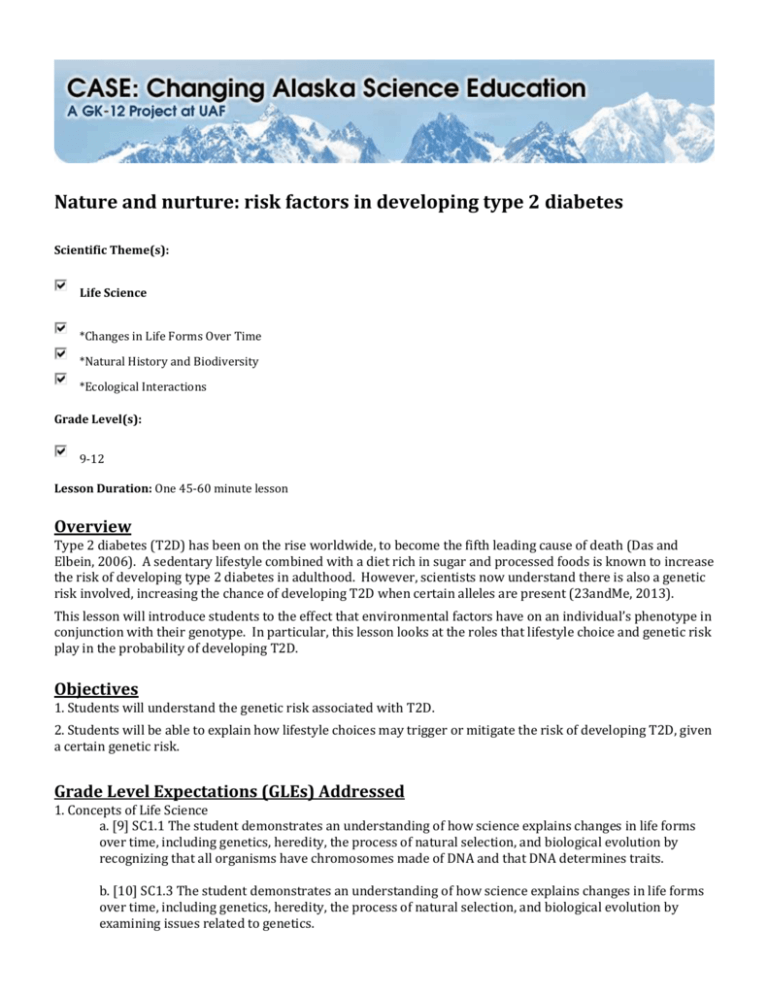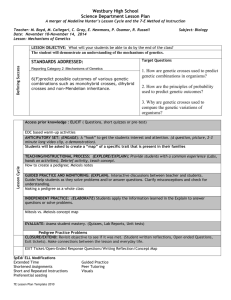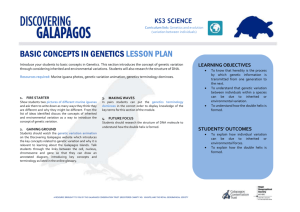Nature and nurture: risk factors in developing type 2 diabetes
advertisement

Nature and nurture: risk factors in developing type 2 diabetes Scientific Theme(s): Life Science *Changes in Life Forms Over Time *Natural History and Biodiversity *Ecological Interactions Grade Level(s): 9-12 Lesson Duration: One 45-60 minute lesson Overview Type 2 diabetes (T2D) has been on the rise worldwide, to become the fifth leading cause of death (Das and Elbein, 2006). A sedentary lifestyle combined with a diet rich in sugar and processed foods is known to increase the risk of developing type 2 diabetes in adulthood. However, scientists now understand there is also a genetic risk involved, increasing the chance of developing T2D when certain alleles are present (23andMe, 2013). This lesson will introduce students to the effect that environmental factors have on an individual’s phenotype in conjunction with their genotype. In particular, this lesson looks at the roles that lifestyle choice and genetic risk play in the probability of developing T2D. Objectives 1. Students will understand the genetic risk associated with T2D. 2. Students will be able to explain how lifestyle choices may trigger or mitigate the risk of developing T2D, given a certain genetic risk. Grade Level Expectations (GLEs) Addressed 1. Concepts of Life Science a. [9] SC1.1 The student demonstrates an understanding of how science explains changes in life forms over time, including genetics, heredity, the process of natural selection, and biological evolution by recognizing that all organisms have chromosomes made of DNA and that DNA determines traits. b. [10] SC1.3 The student demonstrates an understanding of how science explains changes in life forms over time, including genetics, heredity, the process of natural selection, and biological evolution by examining issues related to genetics. Required Background 1. Basic genetics 2. Familiarity with the etiology of type 2 diabetes Vocabulary 1. Alleles 2. Genetics 3. Genotype 4. Phenotype 5. Insulin 6. Diabetes Materials 1. Computer 2. Projector 3. 6-sided dice, 1 per group of 2-3 students 4. Slips of paper with the numbers 1-6 printed on them (at least 1 per student) 5. Slips of paper with +1 printed on them (2X number of students) 6. Slips of paper with -1 printed on them (2X number of students) 7. Plastic grocery bags 8. 1 small piece of candy per student (individually wrapped Jolly Ranchers, Life Savers, etc.) Activity Preparation and Procedure Note: this lesson was adapted from the University of Utah’s Genetic Science Learning Center’s lesson Risk Continuum, which addresses the probability that an individual will develop heart disease. 1. Watch 5 minutes of "Faces of America: Know Thyself” (episode 4), minutes 44:00 to 49:00, found at this link: http://video.pbs.org/video/1409106688 2. In the video, Harvard University Professor Henry Louis Gates Jr. meets with the genetic team that has sequenced his genome. They discuss what phenotypes his genome reveals, and the diseases he is at risk for. On the board, make a list of these risk factors and spend a few minutes discussing them as a class. 3. Show students the website www.23andme.com, where one can get their DNA genotyped inexpensively to reveal disease risk, ancestry, and medication response. Go to the diabetes page (https://www.23andme.com/health/Type-2-Diabetes/) and spend 5 minutes showing the students how genetic risk changes between European, Asian, and African ethnicity. 4. Now, ask each student to draw a slip of paper that will reveal their genetic risk of developing T2D. Each slip of paper has one number between 1 and 6 typed on it. Do not explain what the numbers mean (i.e. high number = high risk, and low number = low risk). Instead, explain that students have an unknown genetic risk of developing T2D, represented by their slip of paper. They have not had any genetic testing done. 5. Students now have to decide on their diet. Offer a piece of candy to each student. If they accept it, they must also take a slip of paper with +1 printed on it. If they decline, they get a slip of paper with a -1 printed on it. 6. Ask students to decide on their activity level. They can do 10 jumping jacks to earn a slip of paper with a -1 printed on it, or they can sit in their seats and relax and earn a slip of paper with +1 printed on it. 7. Students should now add or subtract their lifestyle points (+1,-1) from their original genetic risk. 8. Explain that a 1 (or lower) represents a low risk of getting T2D, and a 6 represents a high genetic risk. Discuss what their new risk is after making their lifestyle choices. 9. To introduce an aspect of randomness, students will now roll a dice to determine whether they will “develop” T2D or not. If they roll a number lower than their risk factor (1-6) then they will develop diabetes. If they role a number equal to or higher than their risk factor, then they will NOT develop diabetes. For example, if a student began with a genetic risk of 4 and made lifestyle choices to reduce that risk to 3, then rolls a 5 on the dice, that student will not develop diabetes. 10. Discuss as a class how lifestyle choices, in conjunction with their genetic risk, affected whether they developed diabetes or not. Some students started with a high genetic risk, and lowered that risk through lifestyle choices and vice-versa. Note: An instructor may choose to reverse the genetic risk (1 is high and 6 is low) and lifestyle points (give a +1 for no candy, and a -1 for candy) to prevent students in earlier classes from revealing the ending to later classes. Students with physical mobility issues may perform an alternate exercise to jumping-jacks. Assessment 1. Ask students to compose a reflective essay on their present lifestyle and family risk of T2D, including changes they may need to make to become healthier. Complementary Activities and Extension Ideas 1. Students may interview relatives to assess their family history and risk of developing T2D. References 23andMe. (2013). Get tested to learn what your genetics say about type 2 diabetes. Retrieved from http://www.23andme.com/health/Type-2-Diabetes/ Das, S.K. and Elbein, S.C. (2006) The genetic basis of type 2 diabetes. Cell Science, 2(4), 100–131. doi: 10.1901/jaba.2006.2-100 and http://www.ncbi.nlm.nih.gov/pmc/articles/PMC1526773/ O’Donnell, G. (Editor), & Ives, S. and Pollak, A. (Directors). (March 2, 2010). Episode 4: Know Thyself [Faces of America, with Henry Louis Gates, Jr.] In B. Goodman, S. Williams, H.L. Gates, Jr., W.R. Grant, P. Kunhardt, D. McGee (Producers). Kunhardt McGee Productions, Inkwell films, Ark Media. http://video.pbs.org/video/1409106688 University of Utah Genetic Science Learning Center. (2013). Risk Continuum. Retrieved from http://teach.genetics.utah.edu/content/health/history/risk_continuum.html









